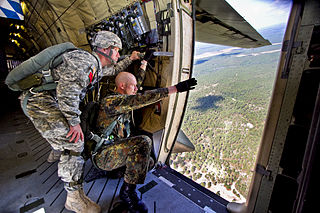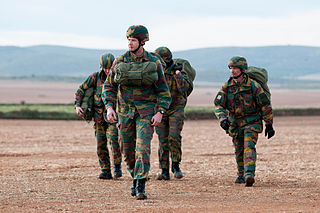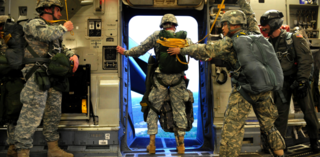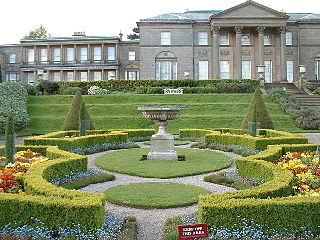
A paratrooper is a military parachutist—someone trained to parachute into an operation, and usually functioning as part of an airborne force. Military parachutists (troops) and parachutes were first used on a large scale during World War II for troop distribution and transportation. Paratroopers are often used in surprise attacks, to seize strategic objectives such as airfields or bridges.

The Parachutist Badge or Parachutist Brevet is a military badge awarded by the Armed Forces of most countries in the world to soldiers who receive the proper parachute training and accomplish the required number of jumps. It is difficult to assess which country was the first to introduce such award.

The Parachutist Badge, also commonly referred to as "Jump Wings" or "Silver Wings" is a military badge of the United States Armed Forces awarded to members of the United States Army, Air Force, Marine Corps and Navy. The United States Coast Guard is the only branch that does not issue its own Parachutist Badge, but its members are authorized to receive the Parachutist Badges of other services in accordance with their prescribed requirements. The DoD military services are all awarded the same Basic Parachutist Badge. The Army and Air Force issue the same Senior and Master Parachutist Badges while the Navy and Marine Corps issue the Navy and Marine Corps Parachutist Badge to advanced parachutists. The majority of the services earn their Basic Parachutist Badge through the U.S. Army Airborne School.

The Glider Pilot Regiment was a British airborne forces unit of the Second World War, which was responsible for crewing the British Army's military gliders and saw action in the European theatre in support of Allied airborne operations. Established in 1942, the regiment was disbanded in 1957.

The United States Army Airborne School – widely known as Jump School – conducts the basic paratrooper training for the United States armed forces. It is operated by the 1st Battalion (Airborne), 507th Infantry, United States Army Infantry School, Fort Benning, Georgia. The Airborne School conducts the Basic Airborne Course, which is open to troops of both genders from all branches of the United States Department of Defense, Reserve Officer Training Corps, and allied military personnel. All students must volunteer to attend the course.
The Parachute Training Wing is one of two training wings in the School of Commandos of the Singapore Armed Forces in Singapore specialising in airborne courses for the Commando Formation. Courses conducted include the Basic Airborne Course, a compulsory course for all Commando trainees, as well as more advanced courses such as the Parachute Jump Instructor Course and the Military Free Fall Course.

Jumpmasters are the expert paratroopers in an airborne unit who train and teach the military techniques for jumping from airplanes. They are responsible for training soldiers who enter Army Airborne School into paratroopers and managing airborne jump operations in airborne units across all branches of services.

The Special Operations Regiment, formerly the Light Brigade, is a Regiment of the Land Component of the Belgian Armed Forces. Its headquarters is located in Heverlee. Known until 3 July 2018 as the Light Brigade the regiment is Belgium's special operations and rapid response unit.
Air Commodore Sir Henry Nigel St Valery Norman, 2nd Baronet, CBE was a consulting civil engineer and Royal Air Force officer during the first half of the 20th century.

No. 613 Squadron was an Auxiliary Air Force later Royal Auxiliary Air Force squadron formed on 1 February 1939 at the then new municipal airport at Ringway, nine miles south of Manchester. The squadron served at first in the army cooperation role, and later during the Second World War became a tactical bomber unit. After the war the squadron reformed as a fighter unit and as such flew until its last disbandment in March 1957.
No. 663 Squadron RAF was an Air Observation Post (AOP) unit of the Royal Air Force (RAF), which was officially formed in Italy on 14 August 1944. Numbers 651 to 663 Squadrons of the RAF were Air Observation Post units working closely with Army units in artillery spotting and liaison. A further three of these squadrons, 664–666, were manned with Canadian personnel. Their duties and squadron numbers were transferred to the Army with the formation of the Army Air Corps on 1 September 1957.
The Basic Parachute Course for members of the British Armed Forces is conducted by the Static Line Training Squadron of No.1 Parachute Training School RAF, based at RAF Brize Norton.

The Esquadrão Aeroterrestre de Salvamento (EAS), known by its nickname Para-SAR, is a Brazilian Air Force special operations search and rescue squadron, based in the city of Campo Grande.
The Central Landing Establishment was the Second World War British development centre for airborne warfare at RAF Ringway airfield near Manchester.
No. 296 Squadron RAF was an airborne forces squadron of the Royal Air Force during World War II. With sister squadrons 295 and 297 it formed 38 Wing, which later expanded to create No. 38 Group RAF.

The United States Army Jumpmaster School trains personnel in the skills necessary to jumpmaster a combat-equipped jump and the proper attaching, jumping, and releasing of combat and individual equipment while participating in an actual jump that is proficient in the duties and responsibilities of the Jumpmaster and Safety; procedures for rigging individual equipment containers and door bundles; personnel parachute components by their specific nomenclature and characteristics; procedures and standards required to conduct a JumpMaster Personnel Inspection (JMPI); the duties and responsibilities of the Drop Zone Safety Officer; the presentation of the Jumpmaster briefing and sustained airborne training (SAT); and the execution of the duties of a Jumpmaster and Safety from a USAF aircraft during a day/night combat equipment jump.
Construction started on Ringway on 28 November 1935 and it opened partly in June 1937 and completely on 25 June 1938, in Ringway parish north of Wilmslow, from which it derived its name Manchester (Ringway) Airport. Its north border was Yewtree Lane. Its southeast border was a little northwest of Altrincham Road (Styal).

The British Armed Forces award a range of Parachutist Badges to those qualified as military parachutists. The version awarded depends largely on the unit or role that the individual fills following qualification.
The Airborne Forces Experimental Establishment (AFEE) was a branch of the British Air Ministry, that researched and developed non-traditional airborne applications, such as gliders, rotary wing aircraft, and dropping of personnel and equipment by parachute, in the period 1942–1950.




















